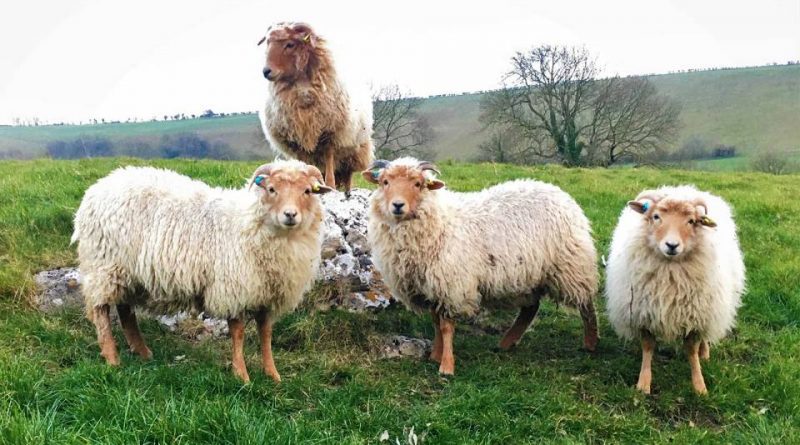Portland
Portland
The Portland (Ovis aries Linnaeus, 1758) is a British sheep breed bred for meat production.
Systematic –
From a systematic point of view it belongs to:
Eukaryota domain,
Kingdom Animalia,
Phylum Chordata,
Mammalia class,
Order Artiodactyla,
Suborder Ruminantia,
Bovidae family,
Subfamily Caprinae,
Genus Ovis,
Species O. aries,
Portland breed.
Geographical and Areal Distribution –
The Portland sheep is a breed of sheep native to England and its traditional breeding area is in the counties of Devon and Cornwall. The breed is so named because it was developed on the Isle of Portland, in the county of Dorset. However, it is important to note that sheep of this breed can also be found outside of traditional farming areas, as they have been exported to other regions of the world.
There are currently 140 registered small flocks growing vigorously in different parts of the UK, including Scotland, Wales and Northern Ireland.
Origins and History –
The Porltand sheep is one of the oldest sheep breeds in Great Britain, as mentioned, originating from the Isle of Portland, a strip of land projected into the English Channel starting from the south-west coast of England near Weymouth, in Dorset.
Once common throughout Dorset, the breed was one of the rarest in Britain and is still at risk. It nearly became extinct in the 1970s, but has now recovered thanks to the efforts of dedicated breeders and the help of the Rare Breeds Survival Trust (RBST).
Even if the breed is benefiting from a recovery program, it is still classified by the RBST (Fund for the Survival of Rare Breeds) as level 4 (at risk). One of the key problems for survival is low numbers: unlike most other breeds whose females regularly give birth to twins, the Portland sheep produces only one lamb per season. Portland lambs also take longer to become mature enough to be killed.
The Portland Sheep Breeders’ Group was created in 1993 with the aim of promoting the breed and providing a discussion forum for breeders. The group operates under the benevolence of the RBST and in 1997 carried out a program to identify available information on the breed and promote its qualities. Annual events have also been organized for farmers: the first was an event on rams in 1997, followed by events on meat, wool and history in subsequent years. The group also runs workshops and participates in local agricultural fairs. The historical link with the territory has been witnessed since the time of the Domesday Book (1086), which reveals that an isolated community with a large flock was established on the island of Portland; the quality of its meat was then widely recognized thanks to the progress of the means of communication. From the mid-19th century onwards, however, numerous radical changes affected the island, with serious consequences on agriculture and the survival of the Portland breed, so much so that in the early 1950s it was brought to the brink of extinction.
Morphology –
The Porltand sheep breed is a robust and good-looking sheep and some sheep have a light woolly covering on the forehead, but the rest of the face is free of wool. The wool is dense and fine, with the characteristic hair (called ‘kemp’) in place of the wool around the tail.
They have an average weight of 60-80 kg for males and 38-40 kg for females.
The legs have thin bones and a uniform light brown color, both the front and hind legs are free of wool from the hock down. The hooves are of a uniform black color, small and straight; the tail is long and sits high on the rump.
The muzzle is light brown but there may be lighter areas around the eyes and mouth, the nose is dark.
The horns are clear, those of the ram are in a multiple spiral while in the females they curve into a half circle. Often there is a black line in one or both horns. At birth, lambs have a fox-red fleece, which changes color in the first months to a creamy white.
Productive attitude –
The Porltand sheep breed is an ideal sheep for small owners thanks to its small size and the small amount of food it needs.
An important characteristic of the breed is the ability to give birth out of season, at any time of the year.
This sheep is raised mainly for meat.
The breed produces exceptionally high quality meat, with excellent consistency and an excellent flavour.
The specialty of the flavor of this meat is given by the longer time it takes to mature and by the recognition of the fact that it is necessary for it to hang for longer to increase the flavor and tenderness that characterize it. Since the meat is naturally lean and delicate, it requires careful butchering to be at its best. Slow cooking also enhances its flavor.
Guido Bissanti
Sources-
– Wikipedia, the free encyclopedia.
– Balasini Dialma, 2001. Applied zootechnics. Sheep and goats. Sheep and goats. For technical and professional institutes, Caledrini Edagricole, Bologna.
– Daniele Bigi, Alessio Zanon, 2010. Atlas of native breeds. Cattle, horses, sheep, goats, pigs raised in Italy, Edagricole-New Business Media, Bologna.
Photo source:
– https://thisisalfred.com/countryside/mary-myers-smallholding-diary-portland-sheep/

